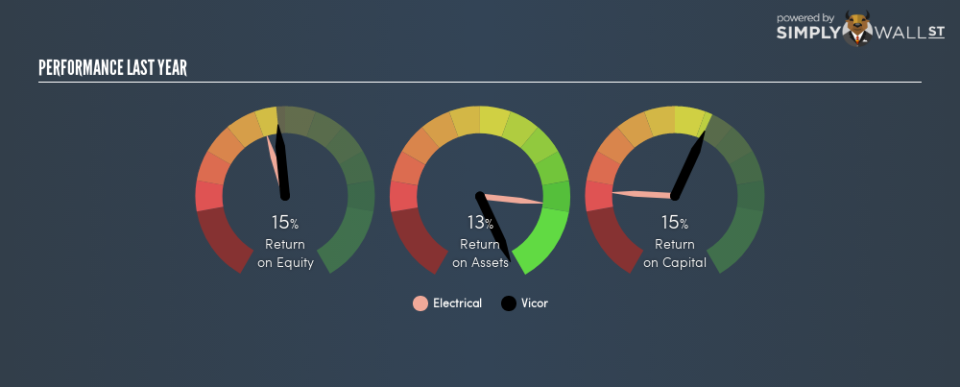Why Vicor Corporation’s (NASDAQ:VICR) Return On Capital Employed Is Impressive

Want to participate in a short research study? Help shape the future of investing tools and you could win a $250 gift card!
Today we’ll look at Vicor Corporation (NASDAQ:VICR) and reflect on its potential as an investment. Specifically, we’ll consider its Return On Capital Employed (ROCE), since that will give us an insight into how efficiently the business can generate profits from the capital it requires.
First, we’ll go over how we calculate ROCE. Second, we’ll look at its ROCE compared to similar companies. Then we’ll determine how its current liabilities are affecting its ROCE.
What is Return On Capital Employed (ROCE)?
ROCE measures the amount of pre-tax profits a company can generate from the capital employed in its business. Generally speaking a higher ROCE is better. In brief, it is a useful tool, but it is not without drawbacks. Author Edwin Whiting says to be careful when comparing the ROCE of different businesses, since ‘No two businesses are exactly alike.’
How Do You Calculate Return On Capital Employed?
The formula for calculating the return on capital employed is:
Return on Capital Employed = Earnings Before Interest and Tax (EBIT) ÷ (Total Assets – Current Liabilities)
Or for Vicor:
0.15 = -US$710.0k ÷ (US$208m – US$31m) (Based on the trailing twelve months to September 2018.)
Therefore, Vicor has an ROCE of 15%.
View our latest analysis for Vicor
Is Vicor’s ROCE Good?
One way to assess ROCE is to compare similar companies. Using our data, we find that Vicor’s ROCE is meaningfully better than the 11% average in the Electrical industry. I think that’s good to see, since it implies the company is better than other companies at making the most of its capital. Independently of how Vicor compares to its industry, its ROCE in absolute terms appears decent, and the company may be worthy of closer investigation.
In our analysis, Vicor’s ROCE appears to be 15%, compared to 3 years ago, when its ROCE was 1.6%. This makes us think the business might be improving.
It is important to remember that ROCE shows past performance, and is not necessarily predictive. ROCE can be deceptive for cyclical businesses, as returns can look incredible in boom times, and terribly low in downturns. ROCE is only a point-in-time measure. You can check if Vicor has cyclical profits by looking at this free graph of past earnings, revenue and cash flow.
Vicor’s Current Liabilities And Their Impact On Its ROCE
Current liabilities include invoices, such as supplier payments, short-term debt, or a tax bill, that need to be paid within 12 months. Due to the way the ROCE equation works, having large bills due in the near term can make it look as though a company has less capital employed, and thus a higher ROCE than usual. To counteract this, we check if a company has high current liabilities, relative to its total assets.
Vicor has total assets of US$208m and current liabilities of US$31m. As a result, its current liabilities are equal to approximately 15% of its total assets. A fairly low level of current liabilities is not influencing the ROCE too much.
What We Can Learn From Vicor’s ROCE
Overall, Vicor has a decent ROCE and could be worthy of further research. But note: Vicor may not be the best stock to buy. So take a peek at this free list of interesting companies with strong recent earnings growth (and a P/E ratio below 20).
If you like to buy stocks alongside management, then you might just love this free list of companies. (Hint: insiders have been buying them).
To help readers see past the short term volatility of the financial market, we aim to bring you a long-term focused research analysis purely driven by fundamental data. Note that our analysis does not factor in the latest price-sensitive company announcements.
The author is an independent contributor and at the time of publication had no position in the stocks mentioned. For errors that warrant correction please contact the editor at editorial-team@simplywallst.com.

 Yahoo Movies
Yahoo Movies 

